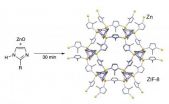(Press-News.org) UEA research shows record high for global carbon emissions
Global carbon dioxide (CO2) emissions are set to rise again in 2012, reaching a record high of 35.6 billion tonnes - according to new figures from the Global Carbon Project, co-led by researchers from the Tyndall Centre for Climate Change Research at the University of East Anglia (UEA).
The 2.6 per cent rise projected for 2012 means global emissions from burning fossil fuel are 58 per cent above 1990 levels, the baseline year for the Kyoto Protocol.
This latest analysis by the Global Carbon Project is published today in the journal Nature Climate Change with full data released simultaneously by the journal Earth System Science Data Discussions.
It shows the biggest contributors to global emissions in 2011 were China (28 per cent), the United States (16 per cent), the European Union (11 per cent), and India (7 per cent).
Emissions in China and India grew by 9.9 and 7.5 per cent in 2011, while those of the United States and the European Union decreased by 1.8 and 2.8 per cent.
Emissions per person in China of 6.6 tonnes of CO2 were nearly as high as those of the European Union (7.3), but still below the 17.2 tonnes of carbon used in the United States. Emissions in India were lower at 1.8 tonnes of carbon per person.
Prof Corinne Le Quéré, director of the Tyndall Centre for Climate Change Research and professor at UEA, led the publication of the data. She said: "These latest figures come amidst climate talks in Doha. But with emissions continuing to grow, it's as if no-one is listening to the entire scientific community."
The 2012 rise further opens the gap between real-world emissions and those required to keep global warming below the international target of two degrees.
"I am worried that the risks of dangerous climate change are too high on our current emissions trajectory. We need a radical plan," added Prof Corinne Le Quéré.
The analysis published in Nature Climate Change shows significant emission reductions are needed by 2020 to keep two degrees as a feasible goal.
It shows previous energy transitions in Belgium, Denmark, France, Sweden, and the UK have led to emission reductions as high as 5 per cent each year over decade-long periods, even without climate policy.
Lead author Dr Glen Peters, of the Centre for International Climate and Environmental Research in Norway, said: "Scaling up similar energy transitions across more countries can kick-start global mitigation with low costs. To deepen and sustain these energy transitions in a broad range of countries requires aggressive policy drivers."
Co-author Dr Charlie Wilson, of the Tyndall Centre at UEA, added: "Public policies and institutions have a central role to play in supporting the widespread deployment of low carbon and efficient energy-using technologies, and in supporting innovation efforts".
Emissions from deforestation and other land-use change added 10 per cent to the emissions from burning fossil fuels. The CO2 concentration in the atmosphere reached 391 parts per million (ppm) at the end of 2011.
These results lends further urgency to recent reports that current emissions pathways are already dangerously high and could lead to serious impacts and high costs on society. These other analyses come from the International Energy Agency, the United Nations Environment Programme, the World Bank, the European Environment Agency, and PricewaterhouseCoopers.
###
The December edition of Nature Climate Change contains three more research papers from Tyndall Centre authors: 'Equity and state representations in climate negotiations' by Heike Schroeder of UEA; 'Changing Social Contracts in Climate Change Adaptation' with Irene Lorenzoni and Tara Quinn of UEA; and 'Proportionate adaptation' by Jim Hall at Oxford University and colleagues from the Tyndall Centres at Southampton University, Cardiff and UEA.
'The mitigation challenge to stay below two degrees' by G.P. Peters, R.M. Andrew, T. Boden, J.G. Canadell, P. Ciais, C. Le Quéré, G. Marland, M.R. Raupach, C. Wilson is published online by Nature Climate Change. http://bit.ly/Qpt3ub (online from Dec 2, 2012, 1800 GMT).
Full details of the methods and data used are presented in: 'The Global Carbon Budget 1959' by C. Le Quéré, R. J. Andres, T. Boden, T. Conway, R. A. Houghton, J. I. House, G. Marland, G. P. Peters, G. van der Werf, A. Ahlström, R. M. Andrew, L. Bopp, J. G. Canadell, P. Ciais, S. C. Doney, C. Enright, P. Friedlingstein, C. Huntingford, A. K. Jain, C. Jourdain, E. Kato, R. Keeling, K. Klein Goldewijk, S. Levis, P. Levy, M. Lomas, B. Poulter, M. Raupach, J. Schwinger, S. Sitch, B. D. Stocker, N. Viovy, S. Zaehle and N. Zeng, Earth System Science Data Discussions. http://bit.ly/UY8GTQ (online from Dec 2, 2012! , 1800 GMT).
Record high for global carbon emissions
2012-12-03
ELSE PRESS RELEASES FROM THIS DATE:
Insights into the genetic causes of coronary artery disease and heart attacks
2012-12-03
In the largest genetic study of Coronary Artery Disease (CAD) to date, researchers from the CARDIoGRAMplusC4D Consortium report the identification of 15 genetic regions newly associated with the disease, bringing to 46 the number of regions associated with CAD risk.
The team identified a further 104 independent genetic variants that are very likely to be associated with the disease, enhancing our knowledge of the genetic component that causes CAD.
They used their discoveries to identify biological pathways that underlie the disease and showed that lipid metabolism and ...
Bismuth provides perfect dance partners for quantum computing qubits
2012-12-03
New research has demonstrated a way to make bismuth electrons and nuclei work together as qubits in a quantum computer.
The discovery, published in Nature Materials, takes us a key step further to creating practical quantum computing which could tackle complex programs that would otherwise take the lifetime of the universe to finish.
The collaboration partners are based in the University of Warwick, UCL, ETH Zurich and the USA Sandia National Labs.
Information on our normal computers is stored as bits, which are either ones or zeros. Quantum bits work differently ...
The role of the cellular entry point of anthrax identified
2012-12-03
Anthrax uses a receptor on the surface of cells to inject its lethal toxins. However, the physiological function of this receptor, named Anthrax Toxin Receptor 2a (Antxr2a), remained unknown until now. A team led by Marcos Gonzalez-Gaitan, a professor at the University of Geneva (UNIGE), Switzerland, in collaboration with Gisou van der Goot at EPFL (École Polytechnique Fédérale de Lausanne), reveals that Antxr2a actually plays a role in embryonic development, orienting cell division along a specific plane, which is a prelude to the formation of future tissues and organs. ...
New gene-sequencing tools offer clues to highest-risk form of a childhood cancer
2012-12-03
Using powerful gene-analysis tools, researchers have discovered mutations in two related genes, ARID1A and ARID1B, that are involved in the most aggressive form of the childhood cancer neuroblastoma. While these findings do not immediately improve clinical treatments, they identify a novel pathway that is defective in these cancers, a pathway that scientists can now study to develop potential new therapies.
"These gene alterations were not previously known to be mutated in neuroblastoma, and they may significantly advance our knowledge of the underlying biological pathways ...
Genes linked to low birth weight, adult shortness and later diabetes risk
2012-12-03
An international team of genetics researchers has discovered four new gene regions that contribute to low birth weight. Three of those regions influence adult metabolism, and appear to affect longer-term outcomes such as adult height, risk of type 2 diabetes and adult blood pressure.
"This large study adds to the evidence that genes have a strong influence on fetal growth," said one of the co-authors, Struan F.A. Grant, Ph.D., associate director of the Center for Applied Genomics at The Children's Hospital of Philadelphia. "The cumulative effect of the genes is surprisingly ...
Scientists at Scripps Research Institute discover how 2 proteins help keep cells healthy
2012-12-03
LA JOLLA, CA – December 2, 2012 – Scientists at The Scripps Research Institute (TSRI) have determined how two proteins help create organelles, or specialized subunits within a cell, that play a vital role in maintaining cell health. This discovery opens the door for research on substances that could interfere with the formation of these organelles and lead to new therapies for cancer.
The study, published online ahead of print on December 2, 2012, by the journal Nature Structural & Molecular Biology, focuses on the structure and function of the two proteins, ATG12 and ...
Scientists find 'bully' genes in common childhood tumor
2012-12-03
In a genome sequencing study of 74 neuroblastoma tumors in children, scientists at the Johns Hopkins Kimmel Cancer Center and the Children's Hospital of Philadelphia (CHOP) found that patients with changes in two genes, ARID1A and ARID1B, survive only a quarter as long as patients without the changes. The discovery could eventually lead to early identification of patients with aggressive neuroblastomas who may need additional treatments.
Neuroblastomas affect nerve tissue throughout the body and are the most common, non-blood cancer in children. "These cancers have a ...
Origin of intelligence and mental illness linked to ancient genetic accident
2012-12-03
Scientists have discovered for the first time how humans – and other mammals – have evolved to have intelligence.
Researchers have identified the moment in history when the genes that enabled us to think and reason evolved.
This point 500 million years ago provided our ability to learn complex skills, analyse situations and have flexibility in the way in which we think.
Professor Seth Grant, of the University of Edinburgh, who led the research, said: "One of the greatest scientific problems is to explain how intelligence and complex behaviours arose during evolution." ...
Childhood trauma leaves mark on DNA of some victims
2012-12-03
This press release is available in German.
Abused children are at high risk of anxiety and mood disorders, as traumatic experience induces lasting changes to their gene regulation. Scientists from the Max Planck Institute of Psychiatry in Munich have now documented for the first time that genetic variants of the FKBP5 gene can influence epigenetic alterations in this gene induced by early trauma. In individuals with a genetic predisposition, trauma causes long-term changes in DNA methylation leading to a lasting dysregulation of the stress hormone system. As a result, ...
A shock to pollution in chemistry
2012-12-03
Solvents are omnipresent in the chemical industry, and are a major environmental and safety concern. Therefore the large interest in mechanochemistry: an energy-efficient alternative that avoids using bulk solvents and uses high-frequency milling to drive reactions. Milling is achieved by the intense impact of steel balls in a rapidly moving jar, which hinders the direct observation of underlying chemistry. Scientists have now for the first time studied a milling reaction in real time, using highly penetrating X-rays to observe the surprisingly rapid transformations as ...


